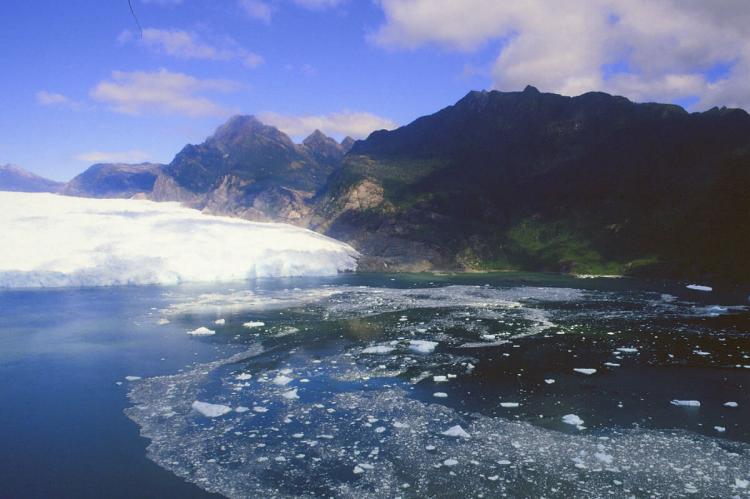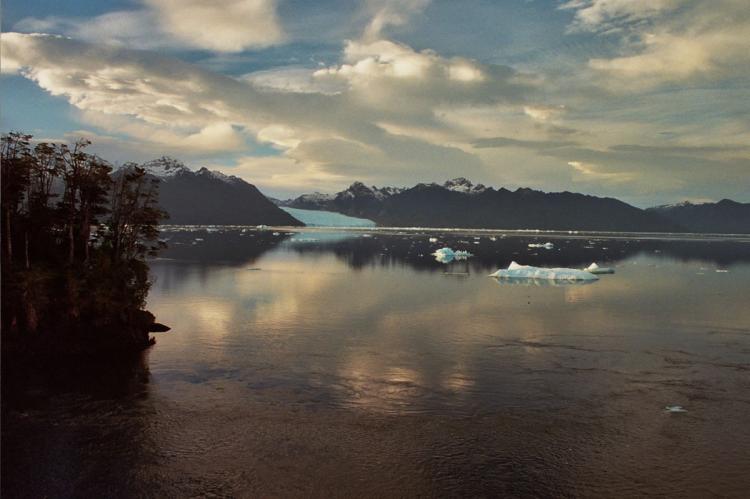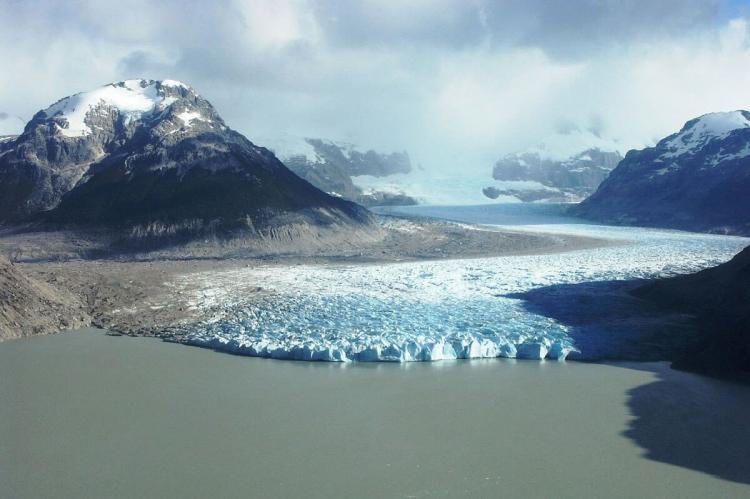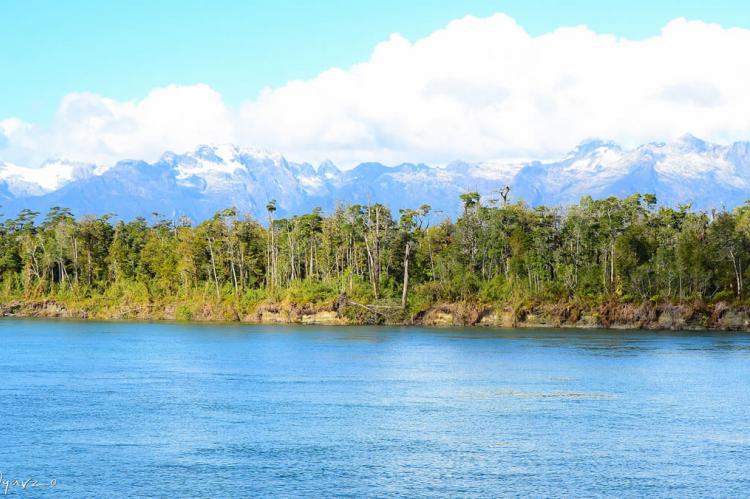Laguna San Rafael National Park and Biosphere Reserve (Chile)
Laguna San Rafael National Park and Biosphere Reserve in southern Chile is an area of highly varied topography and scenic beauty. The area includes the Continental Patagonian Range, the Insular Patagonian Range, the Central Plain, and the Patagonian Glaciers.
Laguna San Rafael National Park
Laguna San Rafael National Park, located on the Pacific coast of southern Chile, occupies an area of 17,420 sq km (6,726 sq mi) and includes the Northern Patagonian Ice Field. It is in the Aysén Region, Chile's most sparsely populated region.
The National Park was created in 1959 to preserve native fauna and flora from extinction. However, the park is also of considerable scientific interest to volcanologists. In addition, its windswept canyons and numerous lakes make it a popular tourist and recreation center. The park was designated a World Biosphere Reserve by UNESCO in 1979.
The park comprises some higher Patagonian Andes, such as the Monte San Valentín, Cerro Arenales, Cerro Hyades, and Cerro Pared Norte.
One of the National Park's main attractions is Laguna San Rafael, a fjord more than 16 km (10 mi) long between the Taitao Peninsula and the mainland, into which the Ventisquero Glacier San Rafael flows.
Many rivers flow through the National Park. For example, the San Tadeo River is located in the Isthmus of Ofqui and flows into San Quintín Bay in the northern Gulf of Penas. In addition, various rivers border the park, such as the Baker and Exploradores rivers.
Témpanos River connects San Rafael Lagoon with the Gulf Elefantes, the southern part of the Moraleda Channel. Presidente Ríos Lake spans the border between the park and Las Guaitecas National Reserve.
The parklands are the ancestral territory of the Chono people. These nomadic people navigated the islands and channels in their canoes, moving between the south of Chiloé and the Taitao Peninsula. They hunted sea lions, fished, and gathered shellfish and seaweed along the coast.
Route of Parks
Laguna San Rafael National Park is part of Chile's scenic 2,800 km (1,700 mi) "Route of Parks" that stretches from Puerto Montt in the north to Cape Horn in the south.
Spanning 17 national parks, the Route of Parks of Patagonia encompasses one-third of Chile and protects over 11.8 million hectares (28 million acres).
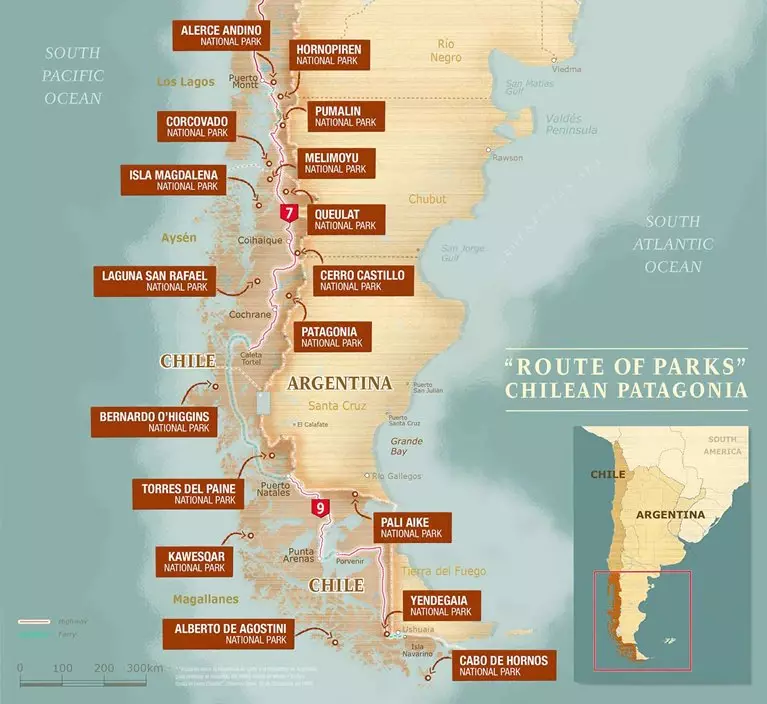
Chile's Route of Parks map - Thompson Conservation
Flora and Fauna
Among the tree species found here are the Coigüe de Magallanes and Coigüe de Chiloé, Mañíos, Canelos, Tepa, Ciprés de las Guaitecas (Pilgerodendron), Tineo, Ulmo, among others. A few of the many shrub species present are Calafate (Magellan Barberry), Michay Blanco, Chaura, Escallonia, and Pangue.
The fauna includes the Huemul (South Andean Deer), Puma, and Guiña (Kodkod). In addition, the park's fjords and channels are home to Toninas (Commerson's Dolphins), sea lions, elephant seals, Chungungos (marine otters), Huillín (southern river otters), and leopard seals.
Several species of birds find shelter in the park, including Chucaos, black-browed albatrosses, great grebes, black-necked swans, and cormorants.
Laguna San Rafael y El Guayaneco Biosphere Reserve.
The Laguna San Rafael y El Guayaneco Biosphere Reserve (formerly the Laguna San Rafael Biosphere Reserve) is located in the Valdivian Forest / Chilean Nothofagus biogeographical region. It is an area of very varied topography and great scenic beauty.
In 2019, the biosphere designation was extended to include the Continental Patagonian Range with rivers and lakes, the Insular Patagonian Range, the Central Plain, and the Patagonian Glaciers. As a result, its total area was increased from 1,742,000 ha (4,304,575 acres) to 5,130,462 ha (12,677,647 acres).
The glaciers feed the Laguna de San Rafael, a large brackish lagoon where there have been past changes in water levels of great scientific interest. It spans four ecological regions: the cold temperate oceanic, the oceanic sub-Antarctic, the oceanic trans-Andean, and the Andean.
The Biosphere Reserve contains high ecosystem diversity. Of the ten plant formations existing in the Aysen Region, seven are found in the Reserve:
-
High mountain deciduous shrubland
-
Aysen deciduous forest
-
Puyahuapi evergreen forest
-
Baker mixed evergreen forest
-
Evergreen coastal shrubland
-
Periglacial shrubland
-
Messier Channel peat bogs and swampy evergreen shrubland
As most of the Biosphere Reserve is coastal, its relevant characteristics are its many estuaries, mudflats, and coastal and beach lands, in addition to a large area of other wetlands, such as peat bogs, swamps, lakes, lagoons, and rivers.
The Northern Patagonian Ice Field is included, covering over 400,000 ha (988,400 acres) with numerous glacier break-offs, with the well-known San Rafael, the main tourist attraction of the XI Aysén Region and one of the most impressive glaciers in the country.
There is no permanent resident population. However, the site has a high potential for ecotourism, and the whole area is available for scientific research. Therefore, priority is given to studies related to management, geology, glaciology, inventory of flora and fauna, vegetation succession, and the ecology of animals of particular interest.
